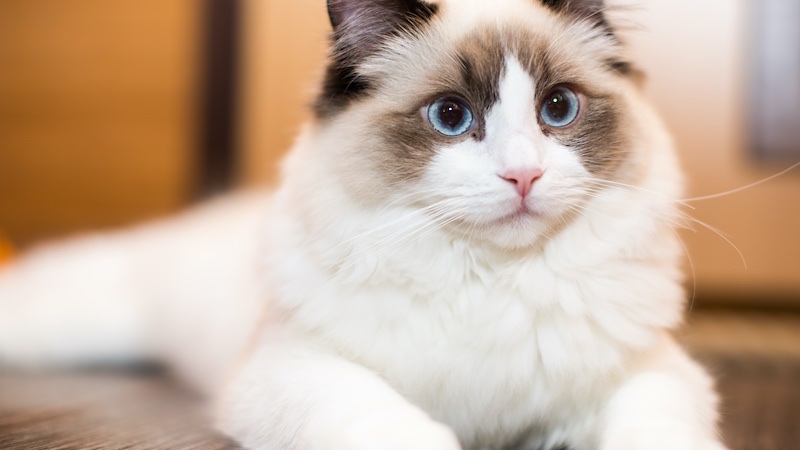Ragdoll cats are a popular breed of indoor cat with a unique look and personality. They are known for their soft fur and easy-going nature, but are Ragdoll cats hypoallergenic? Here we’ll be exploring whether or not Ragdolls may be suitable for homes with people who suffer from allergies.
Ragdoll Cats: Overview

Ragdolls are a cat known for their affectionate and laid-back personalities. They have silky coats that comes in several colors including blue, seal, chocolate, lilac, and red. Ragdolls also have large eyes and ears that give them an alert expression.
Physical Characteristics:
The Ragdoll cat breed is medium to large in size with males typically weighing between 15 to 20 pounds and females weighing 10 to 15 pounds. They have a muscular body type with broad chests and short legs.
Their coats can be either short or medium depending on the variety of Ragdoll you choose. The most common coat color is blue but they can also come in other colors such as seal point (dark brown), chocolate point (light brown), lilac point (pale grayish-brown) or red/flame point (orange).
Temperament:
Ragdolls are known for being gentle and loving companions who enjoy cuddling up with their owners on the couch or bed. They’re very social animals who thrive when given lots of attention from their family members.
They are a cat that loves playtime like fetching toys or chasing after laser pointers but they’re not overly active so they don’t require too much exercise each day. Because of their temperament they are one of the best indoor cat breeds you can find.
Due to their long coat, it is important to brush your Ragdoll regularly in order to prevent matting and tangles from forming. It is recommended that you brush your cat at least once per week using a soft bristle brush specifically designed for cats with long hair like the Ragdoll breed has. Additionally, regular nail trims should be done every two weeks as well as ear cleaning sessions once per month.
Ragdoll cats are known for their loving personalities and beautiful coats, but there is still debate as to whether they are hypoallergenic. To understand this further, it’s important to look at the allergenic proteins found in cats and how these can cause allergies.
Recap: Ragdolls are a popular breed known for their affectionate and laid-back personalities. They require regular grooming, such as brushing once per week, nail trimming every two weeks, and ear cleaning once per month to keep them healthy.
Allergenic Proteins in Cats
These proteins, known as Fel d 1 and Fel d 4, are produced by the sebaceous glands and cat saliva. They become airborne when a cat grooms itself or sheds its coat.
Symptoms of allergies to a cat include sneezing, itchy eyes, runny nose, coughing, wheezing and difficulty breathing. In severe cases, skin rashes may also occur.
The most common treatment for cat allergies is immunotherapy (allergy shots), which involves injecting small amounts of allergen extract into the body over time to help build up tolerance to the allergens present in a cat.
Other treatments include antihistamines or nasal sprays, which can reduce symptoms such as itching and sneezing but do not address the underlying cat allergy itself. Additionally, avoidance measures such as keeping your cat out of certain areas or using air purifiers can help reduce exposure to allergens from cats.
Understanding the source of these Allergenic proteins can help an allergy sufferer reduce their risk. Ragdoll cats can have different coat characteristics that can make them less likely to trigger an allergic reaction, so let’s take a closer look at what makes them hypoallergenic.
Shedding and Coat Characteristics of Ragdoll Cats:

The Ragdoll cat has a short to medium-length coat that does not shed as much as other cat breeds due to its lack of an undercoat. This makes it easier for those with allergies to manage their reactions when around this breed of cat.
They also have minimal dander which further reduces allergen exposure in comparison to other cat breeds.
To reduce your risks even further, weekly grooming should be done on your ragdoll cat using a brush designed specifically for short-haired cats like the rag doll breed.
Additionally, frequent vacuuming will help remove any allergens left behind by your pet’s fur or dander from furniture or carpets in your home environment where you spend time with them often such as sleeping areas or living rooms.
Finally, air purifiers can also help reduce airborne allergens in your home environment caused by pets such as dust mites and pollen particles which are common triggers for allergy sufferers.
Ragdoll Cats: Overview
Ragdoll cats are a relatively new breed of domestic cat, first developed in the 1960s by breeder Ann Baker. They are known for their sweet and gentle personalities, as well as their beautiful blue eyes and silky fur coats.
History and Origin
Ragdoll cats were created from a mixture of several different breeds including Birman, Persian, Burmese, and Angora. The original breeding pair was an all-white female named Josephine and a black-and-white male named Blackie. From this pairing came four kittens that were then bred with other cats to create the Ragdoll we know today.
Symptoms of Allergies to Cats
The symptoms of allergies to cats vary depending on the individual’s sensitivity level and exposure time but generally include sneezing, coughing, wheezing, watery eyes, itching skin or throat irritation.
It is a misconception that cat hair is the cause of the allergic reaction. it is the cat’s saliva and/or the dander in the cat hair that causes the allergy symptoms.
People who suffer from asthma may be particularly sensitive to allergens released by cats and should take extra precautions when interacting with them if possible.
In more severe cases difficulty breathing may occur due to swelling of airways caused by inflammation from contact with allergens present in cat dander.
Treatments for Cat Allergies
Although all cats produce allergens, the amount and type of proteins in Ragdoll cats are different from other breeds. Understanding these differences can help you decide if a Ragdoll cat is the right choice for your home.
Next, we’ll look at how coat characteristics, grooming requirements and shedding habits of Ragdoll cats affect their hypoallergenic qualities.
Recap: The main allergenic proteins found in cats are Fel d 1, albumin and serum albumin. Symptoms of allergies to cats include sneezing, coughing, wheezing, watery eyes and itching skin or throat irritation. Treatments for cat allergies may include avoiding contact with cats where possible, using air purifiers with HEPA filters to reduce the presence of allergens in the home environment and taking antihistamines if necessary.
Ragdoll Cats and Hypoallergenic Qualities
Ragdoll cats are known for their long, silky fur and gentle personalities. But what about their hypoallergenic qualities? In this section, we’ll explore the coat characteristics of Ragdoll cats, their grooming requirements, and their shedding habits to determine if they are hypoallergenic or not.
Coat Characteristics of Ragdoll Cats
Ragdolls have a medium-length coat that is soft and fluffy with no undercoat. Their fur can range from light brown to dark gray in color with white markings on the face, legs, chest, and tail. The texture of the fur is usually fine but may be slightly wavy or curly depending on the individual cat’s genetics. They also have tufts of hair around their ears and between their toes which gives them an extra fluffiness.
Grooming Requirements for Ragdoll Cats

Because of its medium length coat, regular brushing is recommended for a Ragdoll cat in order to keep it looking its best. Brushing should be done at least once per week to remove any loose hairs as well as dirt or debris that may have accumulated in the fur over time.
It’s also important to trim your cat’s nails regularly so they don’t become too sharp or uncomfortable for you when playing together. Additionally, bathing your cat every few months will help keep its skin healthy by removing excess oils that can cause irritation or itching if left unchecked.
Overall, these cats tend to produce less dander compared to other cats, making them a great choice for those who suffer from allergies but still want a furry companion.
Ragdoll cats are a breed that may be more suitable for those with allergies than other breeds due to their coat characteristics, grooming requirements, and shedding habits. To ensure that allergic reactions can be managed effectively when owning a Ragdoll cat, it is important to consider cleaning tips and air purification via a HEPA filter strategy.
Recap: Ragdoll cats are hypoallergenic due to their lack of an undercoat and minimal dander production. Regular brushing, trimming nails, and bathing every few months will help keep their coat looking its best.
Conclusion
When it comes to Ragdoll cats, the question of hypoallergenicity is a common one. While there are no particular cat breed that will be completely free from triggering allergies in people, some breeds may have characteristics that make them more suitable for those with allergies.
Ragdoll cats have several features which may make them better suited for allergy sufferers than other domesticated cats: their thick coats and low-shedding fur; shorter faces and noses; as well as lower levels of dander production compared to other cats. All these factors contribute to making them potentially hypoallergenic pets for those who suffer from pet allergies.
Although there are no guarantees when it comes to finding a truly hypoallergenic pet, Ragdolls do offer certain advantages over other cat breeds when it comes to reducing allergens in your home environment. If you’re looking for an indoor cat companion who won’t aggravate your allergies too much, then this could be the perfect choice.
FAQs
Are Ragdoll cats OK for people with allergies?
Yes, Ragdoll cats are generally considered to be hypoallergenic. They produce less of the Fel d 1 protein that triggers allergies in some people than other cat breeds do. However, it is still possible for someone with allergies to have a reaction when exposed to any cat.
If you or someone in your household has allergies, it is best to spend time around the cat before bringing them home and consult an allergist if necessary.
What are the cons of having a Ragdoll cat?
Ragdoll cats are known for their sweet and gentle personalities, but they can also be quite demanding of attention. They may become overly dependent on their owners and suffer from separation anxiety if left alone for too long. Ragdolls tend to be more vocal than other cat breeds, so they may not be the best choice for people who live in apartments or close quarters with neighbors.
Ragdolls require at least once weekly grooming due to their long coats which can easily become matted if neglected. Finally, these cats have a tendency to gain weight quickly so it is important that you provide them with plenty of exercise and a healthy diet.
Do Ragdoll cats shed very much?
No, Ragdoll cats do not shed very much. They have a medium-length coat that is considered low maintenance and they are known for their minimal shedding. Regular brushing can help keep the coat healthy and reduce shedding even further.
Ragdoll cats also require occasional baths to maintain their fur’s natural luster and texture. With proper care, Ragdoll cats can be a low-maintenance pet that does not shed very much.
What is the number 1 hypoallergenic cat?
The number one hypoallergenic cat is the Siberian Cat. This breed of cat produces significantly less Fel d 1 protein, which is the primary allergen in cats. They have a long, thick coat that requires regular grooming to keep it healthy and free from allergens.
The Siberian also has an outgoing personality and loves human interaction, making them great companions for people with allergies. They are also known for being very intelligent and easy to train, so they can be taught not to go into certain areas of your garden or yard if you don’t want them there.
Do ragdoll cats need to be brushed?
Yes, your Ragdoll cat should be groomed at least once a week to keep his coat in tip top condition.
Why are people not allergic to Ragdoll cats?
The Ragdoll breed of cats have a low level of Fel d 1, the allergen that triggers allergies in many individuals, due to a genetic mutation in the cat’s saliva. This mutation helps decrease the amount of allergen present on the cat’s fur and reduces their potential to trigger an allergic reaction.
Additionally, Ragdolls have a different type of fur than other breeds, which can make them less likely to transfer allergens from one surface to another. Finally, they possess an extremely laid back personality which is often accompanied by minimal shedding; both factors that can contribute to fewer allergy-triggering particles present in the environment.
Are Ragdoll cats good with kids?
If you are considering bringing a Ragdoll cat into your home, one of the most important considerations is how they will interact with your children.
Ragdolls are known to be loyal and gentle cats that form strong bonds with their owners and can be quite affectionate.
They don’t tend to enjoy being handled roughly or having their tails pulled. As such, it’s best for children to learn how to appropriately interact with the cat in order for everyone involved to get the most out of the relationship.
In addition, Ragdolls tend to be friendly towards other animals in the home and have even been described as ‘dog-like’ in behavior due to their trusting personalities.
Conclusion
So, are Ragdoll cats hypoallergenic? The answer is not a simple yes or no. Ragdoll cats do have qualities that make them more suitable for people with allergies than other cat breeds but they still produce allergenic proteins and may cause allergic reactions in some individuals.
Therefore, it is important to be aware of the potential risks before bringing a Ragdoll cat into your home if you or another family member suffer from allergies. With proper care and management techniques such as weekly grooming it is possible to keep both yourself and your pet healthy while enjoying the companionship of a Ragdoll cat.





